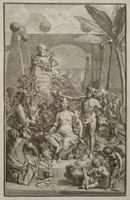
| The conception of the book | ||
| Systematic ordering within the book | ||
| The significance of the Hortus Cliffortianus |
The conception of the book
Linnaeus wrote his book Hortus Cliffortianus in 9 months (!). In this work he described the complete collection of living and dried plant material present at de de Hartecamp, which included many new species. Until this time the individual herbarium sheets owned by Clifford were arranged according to Boerhaavesystem published in his Index alter plantarum.
Hortus Cliffortianus came into existence through collaboration with the best botanical artist of the time, Georg Dionys Ehret. Ehret stayed one month at de Hartecamp where he made the majority of the illustrations. The remainder were sent later from London. Ehret’s plates served as the basis for the etchings of Jan Wandelaar (1690-1759) who made the final prints for the Hortus Cliffortianus.
 |
Wandelaar also made the beautiful, baroque cover (see left, courtesy Special Collections, Library, Wageningen University). For more information regarding the symbolism of this cover, with for example a young Apollo, with the face of Linnaeus, who throws off the mantle of ignorance, click here (in Dutch). In the beginning, Clifford used the Hortus Cliffortianus as a gift for his contacts within the plant-exchange network. Boerhaave and Van Royen were the first to receive a copy of the Hortus Cliffortianus. To view the Hortus Cliffortianus online, click here. > back to the top > back |
Systematic ordering within the book
Linnaeus ranked the plant species according to a sexual system which he himself had designed. The system is based on the number and shape of both male and female reproductive parts which determine the class into which the plant species is placed. Ehret was also indispensable for the rapid dissemination of the underlying concepts of Linnaeus’s new systematic ordering. Through his famous illustrations, Ehret made Linnaeus’s new system more intelligible.
Within this system every species was placed in a genus and given its own unique Latin adjective which often described the character which distinguishes it from the other species. (Example given with picture from HC).
Linnaeus also added synonymies – names which had previously been used by other authors for the same species. Through the use of these synonymies, the herbarium collections which formed the basis of the Hortus Cliffortianus provide a reference to the evolution of the concepts of systematic ordering from Tournefort to Linnaeus.
Occasionally Linnaeus also provided some further information concerning the distribution of the species and a short description thereof.
> back to the top
> back
The significance of the Hortus Cliffortianus
The significance of the Hortus Cliffortianus lies in the fact that this book forms the basis for all of Linnaeus’s subsequent work. Many of the plant descriptions in the Hortus Cliffortianus are repeated, word-for-word, in Linnaeus’s book Species Plantarum which appeared later (1753). In this book Linnaeus introduces the consistent use of the binomial nomenclatural system with a genus name and a species epithet. Many of the names that he used in Species Plantarum are therefore based on species that were housed in the Clifford collection. These collections are therefore type specimens for Linnaeus’ names and are thus invaluable. These plants provide Linneaus’s opinion with regard to a species and should always used at the basic reference.
In 2007, research into biodiversity has become urgent due to its importance for sustainable development, health, nature and environmental policies and climate change. In conjunction with revolutionary development in molecular biology (genomics), information technology and evolutionary biology, the mission that Linnaeus embarked upon in the eighteenth century can now be continued in both greater depth and wider context.
> back to the top
> back